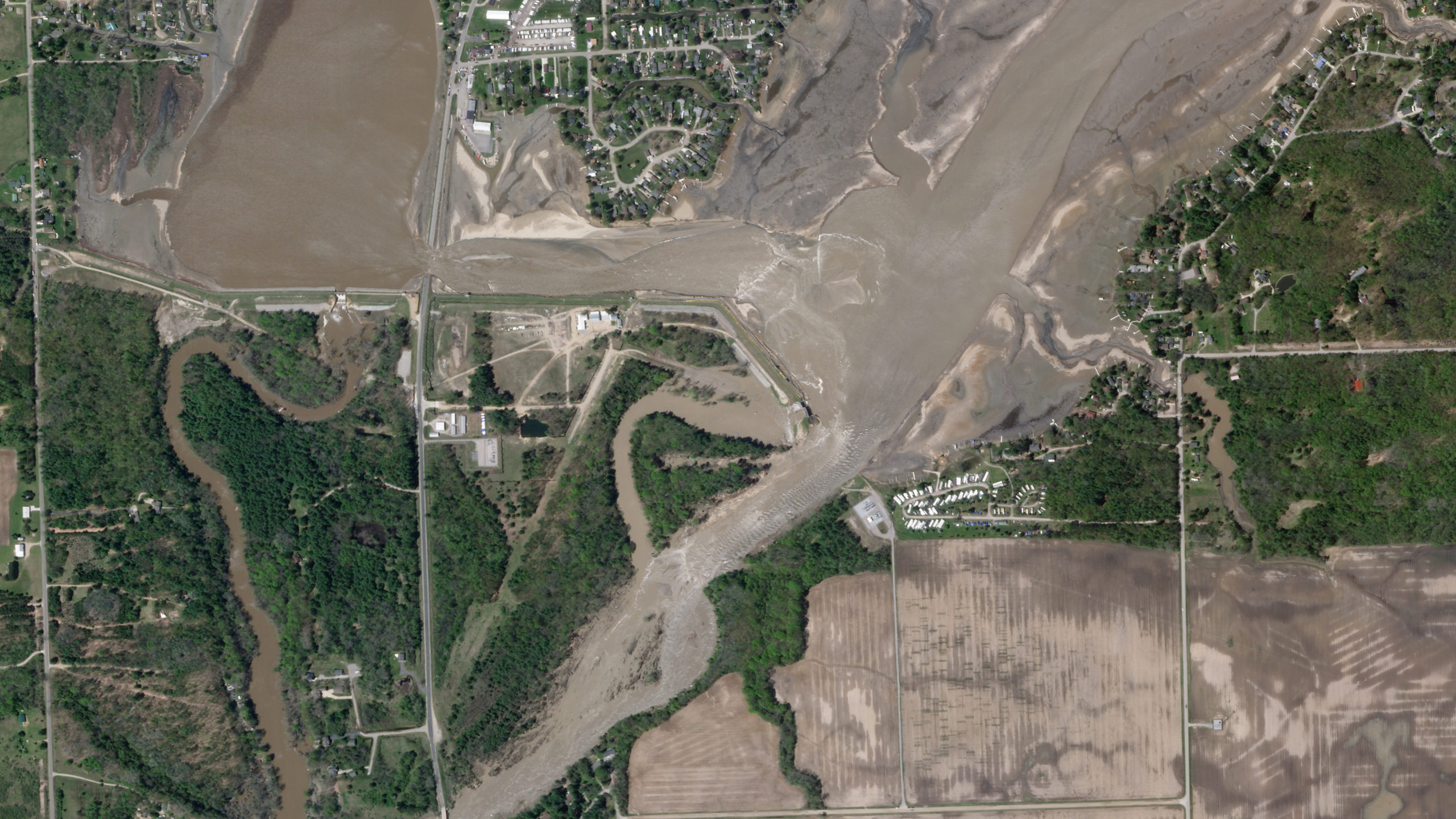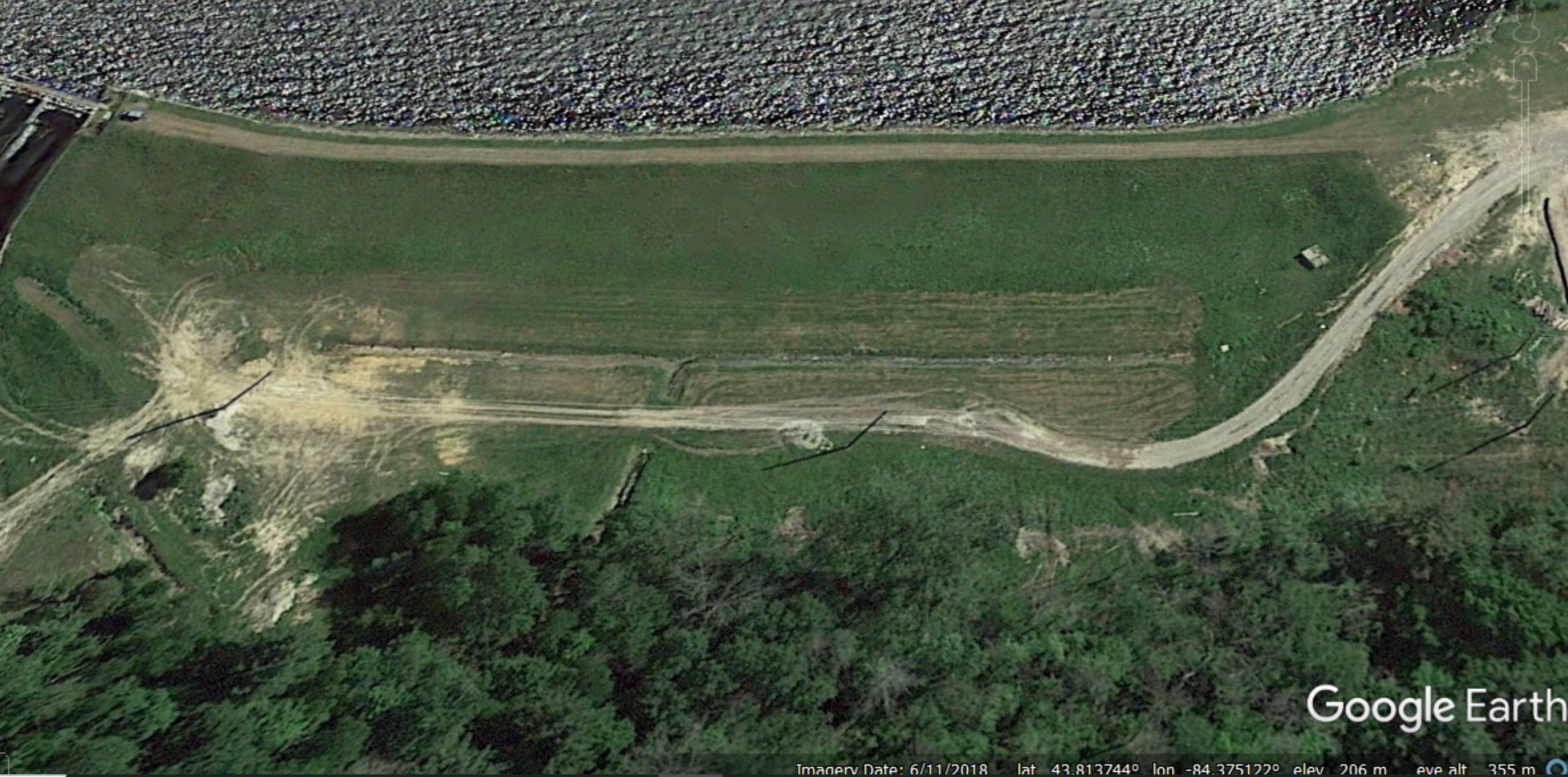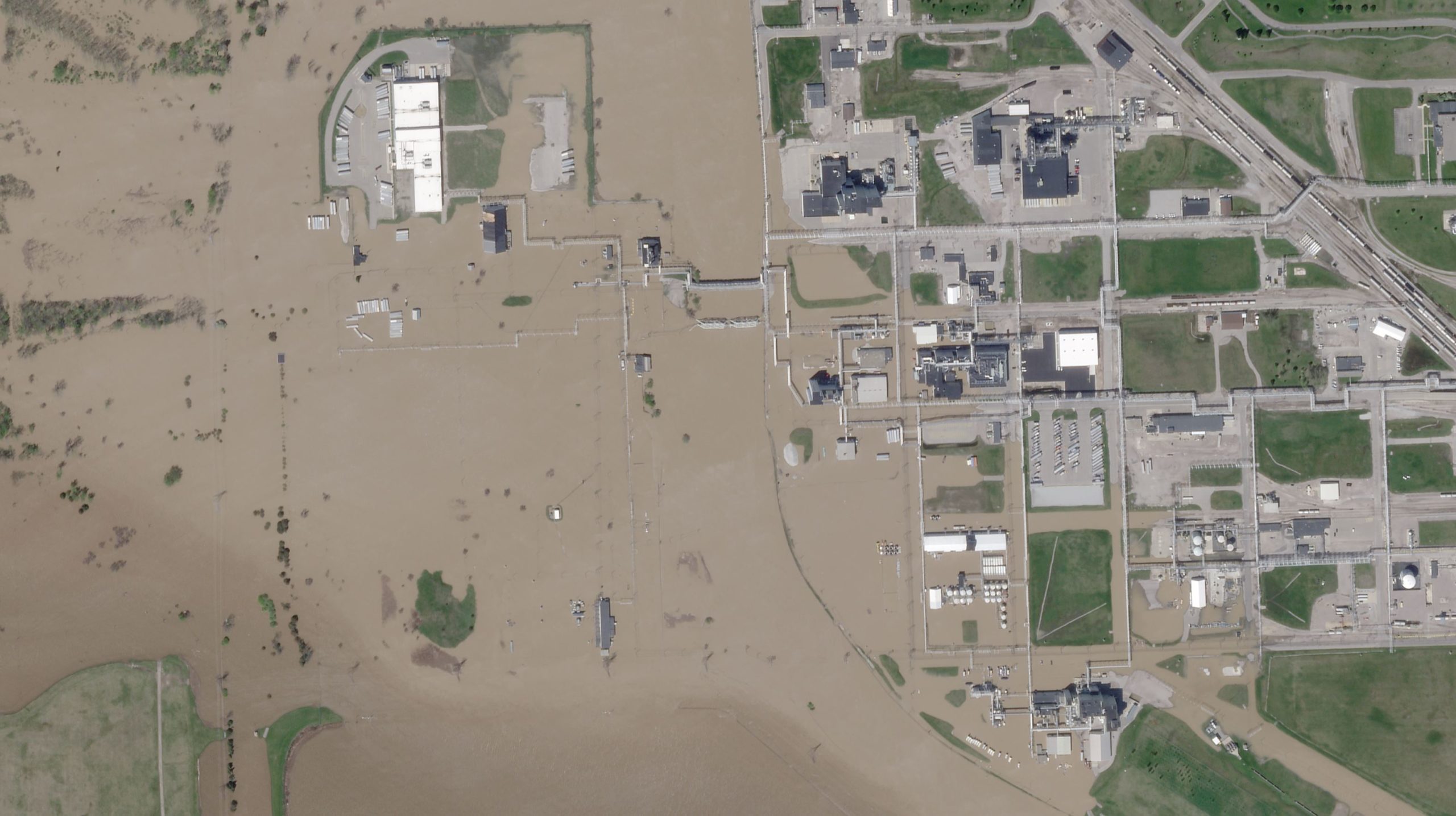22 May 2020
Edenville Dam breach: interpreting the failure
Posted by Dave Petley
Edenville Dam breach: interpreting the failure
Many thanks to all of those who contributed to the discussion yesterday about the catastrophic Edenville Dam breach in Michigan. I thought it would be helpful to summarise views expressed, many of which have come from experts in the field.
First, it is clear that this was not an engineered failure – in other words, it was not planned. There was some discussion on Twitter and in the comments that this was the failure of a fuse plug – i.e. a designed failure point that would release water to prevent overtopping. I can find no evidence that Edenville Dam had a fuse plug, and I do not think that a fuse plug failure would behave in the way shown in the video.
Planet Labs have a wonderful high resolution image of the aftermath of the failure; I wpould be surprised if a fuse plug is intended to leave this type of catastrophic breach:-

Planet Labs image of the aftermath of the Edenville dam breach. Image copyright of Planet Labs, used with permission.
.
The style of failure implies that the dam had become saturated in this area. A key question is going to be why this happened. One suggestion is that the water level exceeded the impermeable barrier, allowing water to flow into the structure. An alternative is that the dam was suffering from seepage prior to the floods. The Google Earth imagery is interesting – this image is from 2018:-

Google Earth image of the site of the Edenville dam breach.
.
Is there an indication here that there was deformation in the dam? Or that works had been undertaken? I’m not sure. It will be interesting to see both the monitoring records for the dam and the maintenance that had been undertaken, as well as the design cross-sections.
The mechanism of failure is undoubtedly a rotational slip. It is possible that this started as a smaller failure at the crest of the dam, which then drove a larger failure in the main face. However, I favour the interpretation that high pore water pressures, and a loss of unsaturated conditions, through the dam volume drove the failure. There are some indications in the video that high pore water conditions were present in the lower part of the structure.
Readers have rightly pointed out that earthfill embankment dams are not unusual and, when well designed and maintained, they are not unsafe. This dam was completed in 1924. However, these structures do require maintenance – would you expect a train built in 1924 to still work without extensive restoration – and they were designed for a time when rainfall levels were different. Climate change – global heating – is driving increases in rainfall intensities and durations, meaning that the Probable Maximum Flood is increasing in very many places.
I always get howls of protest when I say that climate change is important, but it is the case. These structures, worldwide, are going to need a substantial upgrade to cope with that increase in rainfall, and that’s going to be very expensive. In the interim we will see more failures of this type.
There is also some interesting analysis of the performance of the dam prior to failure online, using INSAR data. It is astonishing that such an interpretation can be generated so quickly. At present I find it hard to interpret this data though – the results seem to indicate deformation across much of the structure, and the section that failed seems to show uplift not, as I would expect, subsidence. This needs further work, but INSAR remains an exceptionally exciting area of work for these types of investigations, and for pre-failure monitoring.
The failure of the dam is a catastrophe for people living in this area. Planet Labs have an online gallery of high resolution images of the impacts. The Planet Labs image below shows some of the downstream flooding for example:

Planet Labs image of the aftermath of the Edenville dam breach. Image copyright of Planet Labs, used with permission.
.
But we must not forget that the effects lie upstream as well. There are numerous houses located around the lakes whose value will have been based upon the proximity to the water. The failure of the dam will have a profound impact, and of course the ecology of the lakes will also have been destroyed.
.
On reflection 1: my most successful blog day
The past 24 hours have been my most successful day in the 12 years of this blog, with almost 50,000 individual visits. Thank you.
.
On reflection 2: Controversy over the protection of the Great Western Railway in Devon from landslides
In Teignmouth in Devon in SW England there is controversy over plans by Network Rail to change the alignment of Isambard Kingdom-Brunel’s wonderful Great Western Railway to protect it against landslides. The article claims that the cost of these works is £500 million.
.
Reference
Planet Team (2020). Planet Application Program Interface: In Space for Life on Earth. San Francisco, CA. https://www.planet.com/


 Dave Petley is the Vice-Chancellor of the University of Hull in the United Kingdom. His blog provides commentary and analysis of landslide events occurring worldwide, including the landslides themselves, latest research, and conferences and meetings.
Dave Petley is the Vice-Chancellor of the University of Hull in the United Kingdom. His blog provides commentary and analysis of landslide events occurring worldwide, including the landslides themselves, latest research, and conferences and meetings.
It appears to me from the video in your previous post that the failure occurred about 3/4 of the way along the straight section before the bend to the spillway, and in the video that bare area appears to be from vehicles turning on the downstream side of the ditch along the bottom of the dam slope, and thus unrelated to recent work on the slope ?
There appears to have been a vehicle on the dam slope, but that could be just an inspection access or even hooning like my mates did in 4WDs on an ash dam here in NSW.
I have my theory for the initiating failure mode. I believe this was an internal erosion issue, which caused a void in the embankment. This void collapsed, which is the crest/upstream failure just before the downstream failure. Once that occurred, it created a direct seepage path along the failure plane, which caused the slide (you can see the slide riding along the water).
My evidence for this is the lack of a toe drain. A toe drain was installed along the embankment up to the spillway/outlet works. The portion past the spillway/outlet works where the failure occurred did not have the toe drain. This toe drain would have helped to control the pore pressure within the foundation and embankment, and would have provided a berm at the toe for added stability. This is my working theory based on my knowledge working as a geotech on major dam safety projects, mainly earthfill embankment dams.
my reading of the Detroit News is that the fuse plug was on the downstream Sanford Dam to the right of its spillway.
The Trump Administration is now demanding that Michigan investigate Hunter Biden. They are saying that he is the one who caused the Edenville Dam Breach. The Trump Administration is threatening to withhold all funds for disaster relief for tis disaster as well as the Pandemic until they cooperate and agree to investigate Biden’s role in the Dam breach.
Seriously – this collapse looks very similar in mechanism to that large tailings dam failure documented here last winter. It reminds me of the Tieton Dam failure in Idaho. A friend of mine, Paul Libby who I was arrested with at an antinuclear protest in 1977 was one of the engineers working for the Bureau of Reclamation on that project. Before they built it he predicted their design would fail exactly in the matter that it did and they ignored him. He resigned in protest, and watched in horror as they filled the reservoir only to see it fail exactly how he predicted. The local money interests overrode any kind of science. Similar to how the Trump Administration has turned away from Science and is now ordering all of the Churches to open their doors! It doesn’t surprise me in the least that this dam failed and I wonder what other natural disasters will happen while our Federal Government is asleep at the wheel or high on drugs.
Dave, I enjoy reading your summary, Regarding the InSAR I agree it needs to be evaluated closer. Given the orbit direction and line of site the blue on the face may have been indicating heave occurring along the face dating back about 6 months or more. I am not sure why the red indicates significant subsidence near the toe. There is a lot of persistent reflection on this structure that were telling a story that we should have paid attention to.
The INSAR data are intriguing.
As you correctly note, we still have a lot of unknowns*
However, heaving/ uplift would be consistent with a reduction in effective stress within the structure.
The 1925 date of construction was probably too early for any of the engineers involved to have read;
Either;
Casagrande’s work on effective stress.
Or,
Terzaghi’s work on filter media.
From memory, I think it was late 1960s / early 1970s when internal erosion in one of the Baldersdale dams in North East England, indicated that even Terzaghi’s criteria could be inadequate, and tighter criteria were needed, leading to the “ideal” filter criteria.
________________________________
* a selection of the unknowns
We don’t know the intended design of the dam, or the actual construction methods used, actual placement of materials(end tipping vs compaction in layers and orientation of those layers), or the properties of those materials (grain size distributions, Atterburg limits, swelling/ consolidation characteristics…)
I’ve deliberately not mentioned shear strength
The differences in the colours and thickness of vegetation on the downstream surface does suggest differences in material types / grain sizes and moisture content
For what it is worth, the location where the failure occured, is where the Tittabawasee river bed was—before the dam was built. In effect, the river restored itself in this event.
One can easily see the old riverbed…tree covered in Google maps.
It makes me suspect of the material and construction done in the old river basin.
In my view the failure of endvil dam is caused especially by the reduction of the materials properties ( cohesion of clay is reduced) after the important saturation of the downstream slope ,in the video we saw the tipically failure of an earth dam (circular failure), the overtopping is second important cause of failure.
the Fed government has been asleep or high on drugs for decades – Trump has nothing to do with any of this – the power lies in Congress and the House – don’t kid yourself, a President is mostly a talking head and has little power. Educate yourself a little before you throw current politics into your comments. Trump may be a bonehead, but he can’t do anything about these disasters without permission from Congress or the House. all of this fake stimulus money could have went to hiring people and training them to fix bridges and dams and roads, etc…. instead of making it a welfare and letting people just sit out on the couch and spend money that I earned and was stolen from me by our government.
Has anyone come across a design cross section? I’d like to use it for a presentation. Thanks.